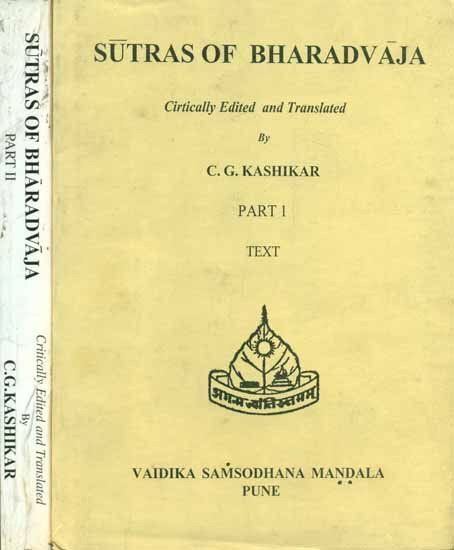Bharadvaja-srauta-sutra
by C. G. Kashikar | 1964 | 166,530 words
The English translation of the Bharadvaja-Srauta-Sutra, representing some of the oldest texts on Hindu rituals and rites of passages, dating to at least the 1st millennium BCE. The term Srautasutra refers to a class of Sanskrit Sutra literature dealing with ceremonies based on the Brahmana divisions of the Veda (Sruti). They include Vedic rituals r...
Praśna 11, Kaṇḍikā 2
1. Then he should recite over the earth dug out by a hog the formula, “Thou wast so much extensive at first.”[1]
2. The further procedure should be similar.[2]
3. He should recite over the ant-bill the formula, “O divine ants, you, the righteous, are born first of all this creation.”[3]
4. The further procedure should be similar. [4]
5. He should recite over the pūtīka plant the formula, “Thou art the vigour of Indra.”[5]
6. The further procedure should be similar.[6]
7. (He should recite over) the hair of the skin of a black antelope and of a goat mixed together the formula, “Thou art born of fire, the semen virile of Prajāpati.”[7]
8. The further procedure should be similar.[8]
9. He should cause the horse to smell these (substances) with the formulas, “Give (me) long life; give me Prāṇa; give me Apāna; Give me Vyāna; give me eye; give me ear; give me mind; give me speech; give me body; give me stability; give me measure; give me (all this).”[9]
10. With the formula, “May the sweet make thee sweet,”[10] he should cause the she-goat to be milked over them.
11. Some teachers prescribe the milking over before the smelling (by the horse).
12. Many Āryas should catch hold of (the skin together with the substances) and carry.
13. They should put it down towards the north of the sanctuary on a place which has been dug out, (which is) sprinkled with water by means of the hand with the palm turned downwards, (which is) covered with gravel, and (which is) enclosed.
14. With the formula, “May the sweet sweeten thee,”[11] he should add madantī-waters to them (= the substances).
15. (He should also add) the substances prescribed for preparing a cauldron[12] and any other material for hardening in such a way that they would together amount to about half the quantity (of the earth).
16. In this connection this is the general rule: whatever in the Pravargya is to be accomplished with water, should be accomplished with the madantī-waters.
17. Neither a woman nor a Śūdra should gaze at the Pravargya.
18. One should not breathe over (the Pravargya-utensils) while preparing them.
19. Turning away his face, he should prepare (the Pravargya-utensils) by means of a bamboo, without:breathing over them.
20. One should not pass between the Pravargya and the sun.
21. If the sun sets while the Pravargya-rite is going on, one should stop the procedure. Next day he should finish the rest of the procedure,
22. With the formula, “Thou art the head of sacrifice,”[13] the Adhvaryu should crush the earth, and make a ball out of it.
23. With the formula, “You two are the spots of sacrifice,”[14] he should mould the ball by means of his two thumbs, and prepare a Mahāvīra, one span high or of undefined height, resembling a wooden cup, and having three elevations or five elevations.
24. With the formula, “I prepare thee with the Gāyatrī metre,”[15] he should prepare the first (Mahāvīra); with the formula, “I prepare thee with the Triṣṭubh metre,”[15] he should prepare the second; with the formula, “I prepare thee with the Jagatī metre,”[15] he should prepare the third.
25. Or he should prepare each of the Mahāvīras with all the three formulas.
26. With the formula, “Thou art the girdle of sacrifice,”[16] he should prepare the girdle near the hollow.
27. With the formula, “May Aditi hold the hollow with the Paṅkti metre,”[17] he should prepare, by means of a portion of a bamboo, so big a hollow as he may consider to be adequate for holding the principal oblation,[18] the Sviṣṭakṛt oblation,[19] the Agnihotra oblation,[20] and the remnant for partaking.[21]
Footnotes and references:
[1]:
Taittirīya-āraṇyaka IV.2.3.
[2]:
XI.l.15-18.
[3]:
Taittirīya-āraṇyaka IV.2.3.
[4]:
XI.1.15-18.
[5]:
Taittirīya-āraṇyaka IV.2.3.
[6]:
XI.1.15-18.
[7]:
Taittirīya-āraṇyaka IV.2.3.
[8]:
XI.1.15-18.
[9]:
Taittirīya-āraṇyaka IV.2.3.
[10]:
Taittirīya-āraṇyaka IV.2.3.
[11]:
Taittirīya-āraṇyaka IV.2.3.
[12]:
At the piling up of the fire-altar, cf. Note to XI.1.4.
[13]:
Taittirīya-āraṇyaka IV.2.5.
[14]:
Taittirīya-āraṇyaka IV.2.5.
[15]:
Taittirīya-āraṇyaka IV.2.5.
[16]:
Taittirīya-āraṇyaka IV.2.5.
[17]:
Taittirīya-āraṇyaka IV.2.5.
[18]:
XI.10.10.
[19]:
XI.10.11.
[20]:
XI.11.10.
[21]:
XI.11.12.
